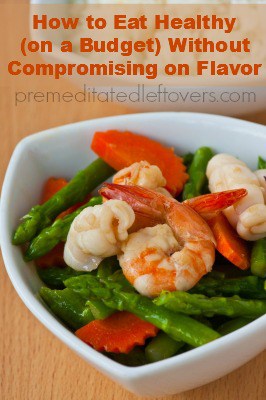
1. Grow your own garden. While farming is a lot of work, gardening is done on a much smaller scale and is actually feasible for most families. Even if you live in an area where gardening isn’t popular, there are many ideas online to help you create your own little garden. I personally love to grow tomatoes and hot peppers. Herbs and spices can also be grown inside, which is a great way to save on seasonings while kicking the flavor up a notch or two!
2. Meal plan! I know this seems like a simple task – and it can be – but it takes organization. Sit down with a pen and paper (or Excel spreadsheet if you’re all high-tech and stuff) one day each week and browse Pinterest or FoodGawker for recipe inspiration. Keep it simple (just a few ingredients) and healthy. Don’t get distracted by the chocolate. 😉
3. Eat less meat. As we all know, meat is expensive! And if it’s not expensive, it’s usually not very healthy, right? So, obviously eating less meat will take a bit of the strain off of your healthy grocery bill.
4. Eat more grains. You still want to get full, and be satisfied with your meals – so eat more grains, beans, and legumes. You can get a box of whole wheat pasta for a buck. Portion control is key.
5. Purchase in bulk. Shop at Costco, Sam’s, etc and purchase some foods in bulk. Stay away from the trap of “convenience” foods, though – they are NOT healthy. Bulk food purchases give you a lower price per quantity ratio while saving on packaging.
6. Shop at the farmer’s market. Buy local when you can. Not only will you be supporting local farmers and growers, you’ll most likely be paying a lot less than you would at the grocery store.
7. Sign up for a food swap or co-op. Have you searched for fruit and veggie co-ops in your area? If not, now’s the time! Everyone pitches in a bit of cash to get a big basket of fresh fruits and vegetables! Check out Local Harvest, or use Google to find one in your area.
8. Eat seasonally. On the same note as above, eating seasonally will help you save moolah, too! When you eat items that are in season, you’re paying a lot less! I can get avocados for less than 50 cents a piece when they’re in season. When they’re not, they can be up to $3 a piece!
9. Try canning. Canning isn’t for everyone, but it’s a great (affordable!) way to preserve in-season foods. Also, drying, and freezing fresh fruits and vegetables are excellent ways to stock up on seasonal foods that are lower in cost but higher in taste (and nutrition!).
10. Limit certain foods. Junk food, alcohol, soda, salty and sugary foods — those are all things that will make you put on weight, and spend money that you don’t need to! Avoid processed foods whenever possible.
Here is a list of 25 Healthy Foods for Under $1.00. That should help you get started on your Healthy Eating on a Budget!
How do YOU eat healthy on a budget?
Sadie is sharing her weight loss journey on her blog Slap Dash Mom.

Leave a Reply